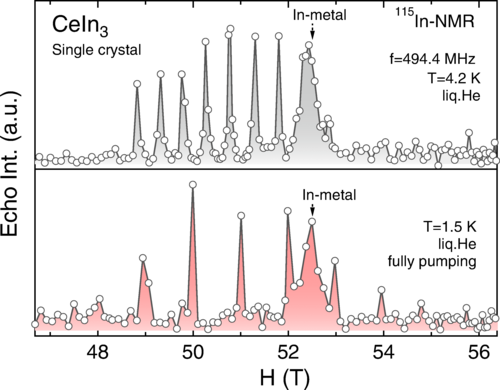Yo Tokunaga, JAEA Tokai, Nicolas Bruyant, LNCMI-Toulouse, and Ilya Sheikin, LNCMI-Grenoble.
Heavy-fermion materials exhibit a diverse range of fascinating phenomena including quantum phase transition (QPTs), non-Fermiliquid behavior, and novel states of matter such as unconventional superconductivity. The application of high magnetic fields often induces additional phase transitions, such as metamagnetic and Lifshitz transitions. In many cases, however, the exact origin of field-induced phase transitions in heavy-fermion compounds remains poorly understood.
CeIn3 is one of the simplest and best-studied heavy-fermion compounds. At ambient pressure and zero magnetic field, it exhibits antiferromagnetic (AFM) order below 10 K. A small dome of superconductivity emerges around a pressure-induced QPT from the AFM to paramagnetic (PM) phase. The AFM order can be also suppressed by a magnetic field, in which a field-induced QPT occurs at the critical field Hc, which varies from 60 to 80 T, depending on the field orientation. However, a QPT is not the only feature induced in CeIn3 by high magnetic fields. Indeed, a clear anomaly was discovered in tunnel diode oscillator measurements at H* ≈ 45 T, well below Hc. The physical origin of this transition, or crossover, is at present obscure. A possible explanation for this feature is a field-induced change of the magnetic and/or crystal structure.
In order to shed more light on the origin of the high-field anomaly in CeIn3, researchers from Grenoble and Toulouse, together with Japanese colleagues, performed a high-magnetic-field NMR study using a pulsed magnet. This was the first successful pulsed-field NMR experiment in a heavy-fermion compound. A clear change in the NMR spectrum between 4.2 K and 1.5 K (Figure) confirms that a magnetic phase transition from PM to AFM states occurs between the two temperatures. This in turn ensures that the metallic crystal in the pumped 4He cryostat stayed well below ˜4 K despite possible heating due to the high-field pulse. No visible change was detected in pulsed-field NMR spectra across H*. Thus, the 45 T anomaly in CeIn3 cannot be simply ascribed to a field-induced change of magnetic or crystal structure at H*.

Figure: Field-swept NMR spectra obtained at two temperatures in a pulsed magnet with a fixed NMR frequency of 494.4 MHz.
High-field phase diagram of the heavy-fermion metal CeIn3: Pulsed-field NMR study on single crystals up to 56 T, Y. Tokunaga, A. Orlova, N. Bruyant, D. Aoki, H. Mayaffre, S. Krämer, M.-H. Julien, C. Berthier, M. Horvatić, N. Higa, T. Hattori, H. Sakai, S. Kambe, and I. Sheikin, Phys. Rev. B 99, 085142 (2019).
https://journals.aps.org/prb/abstract/10.1103/PhysRevB.99.085142
Contact: ilya.sheikin@lncmi.cnrs.fr







Leave A Comment
You must be logged in to post a comment.